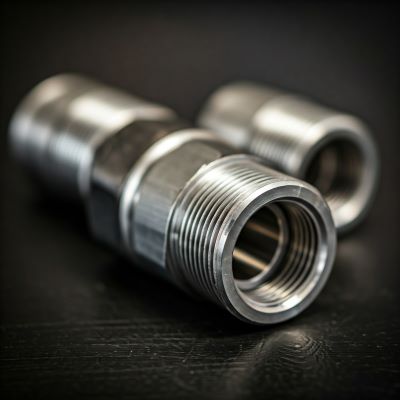Numerous sectors rely on hydraulic systems to operate everything from large machinery to sensitive medical devices. Within these systems, fluid connections play a pivotal role in ensuring smooth and efficient operation. A crucial component in these connections is the hydraulic fitting ferrule.
The Fundamentals of Hydraulic Ferrules Fitting
What are hydraulic ferrules fittings?
Hydraulic fitting ferrules are small, precision-engineered components that are inserted into hose fittings to create a secure and leak-proof seal. They are typically made of metal, such as brass, steel, or stainless steel, and are designed to compress the hose material onto the fitting when tightened.
Materials commonly used in ferrule manufacturing:
➡️ Brass: Offers good corrosion resistance and machinability.
➡️ Steel: Provides high strength and durability, especially in high-pressure applications.
➡️ Stainless Steel: Offers excellent corrosion resistance and can withstand harsh environments.
Basic design and engineering behind ferrules:
Ferrules are engineered to have specific dimensions and tolerances to ensure a proper fit with the hose and fitting. The design often incorporates a tapered or conical shape to facilitate the sealing process.
Ensuring Leak-Free Connections
How ferrules create a secure seal in hydraulic systems:
When a ferrule is tightened, it compresses the hose material against the fitting, creating a mechanical seal. The precision engineering of the ferrule ensures a tight fit, preventing fluid leakage.
Importance of precision engineering in preventing fluid leaks:
Even the slightest misalignment or imperfection in a ferrule can lead to fluid leaks, compromising system performance and safety. Precision engineering is essential to guarantee the integrity of the seal.
Enhancing System Efficiency
The role of ferrules in maintaining consistent fluid pressure:
Leak-free connections are crucial for maintaining consistent fluid pressure throughout the hydraulic system. Ferrules help to prevent pressure drops and fluctuations.
Reducing energy waste caused by inefficient fluid flow:
Leaks and pressure drops can lead to energy waste. By ensuring efficient fluid flow, ferrules contribute to energy savings and reduced operational costs.
Examples of industries benefiting from optimized fluid connections:
➡️ Manufacturing: Hydraulic systems power various manufacturing processes, and ferrules help to improve productivity and reduce downtime.
➡️ Mining: Heavy-duty mining equipment relies on hydraulic systems. Ferrules help to maintain system reliability and safety.
➡️ Oil and Gas: Hydraulic systems are used in drilling, production, and transportation. Ferrules contribute to efficient and environmentally responsible operations.
Durability and Longevity of Hydraulic Ferrules Fitting
Impact of ferrule material choices on system durability:
The choice of material for a ferrule can significantly impact its durability. Stainless steel ferrules, for example, offer excellent corrosion resistance and can withstand harsh environments.
How ferrules withstand high pressure and harsh environments:
Ferrules are designed to withstand high pressures and extreme temperatures. The material selection and engineering ensure that they can perform reliably in demanding conditions.
Maintenance tips to extend the lifespan of hydraulic ferrules:
➡️ Regular inspection for signs of wear or damage
➡️ Proper tightening torque to avoid over-tightening
➡️ Avoiding exposure to excessive heat or chemicals
Compatibility with Various Hydraulic Components
Designing ferrules for compatibility with diverse hose fittings:
Ferrules are designed to be compatible with a wide range of hose fittings, including SAE, JIC, and metric fittings. The dimensions and tolerances of the ferrule must match those of the fitting to ensure a secure connection.
How ferrule design adapts to specific system requirements:
Ferrules can be customized to meet specific system requirements, such as high-pressure or high-temperature applications. Special coatings or materials may be used to enhance performance.
Innovations in ferrule technology for better integration:
Ongoing advancements in ferrule technology, such as improved materials and manufacturing processes, are leading to more reliable and efficient connections.
Choosing the Right Ferrules for Your Hydraulic System
Key factors to consider when selecting ferrules:
➡️ Hose and fitting compatibility: Ensure the ferrule is compatible with the specific hose and fitting types used in your system.
➡️ Pressure rating: Select a ferrule that can withstand the maximum pressure in your system.
➡️ Temperature range: Consider the temperature extremes your system may experience.
➡️ Material compatibility: Choose a ferrule material that is compatible with the fluid being used.
Common mistakes to avoid during installation:
➡️ Over-tightening: Over-tightening can damage the ferrule and hose.
➡️ Incorrect installation: Improper installation can lead to leaks and system failures.
➡️ Using incompatible components: Mixing incompatible components can compromise the integrity of the connection.
Recommended practices for achieving optimal system performance:
➡️ Regular inspection: Inspect ferrules for signs of wear or damage.
➡️ Proper torque: Use the recommended torque when tightening ferrules.
➡️ Quality components: Use high-quality ferrules and fittings from reputable manufacturers.
Conclusion
Hydraulic ferrules fittings are essential components that play a critical role in ensuring the reliability and efficiency of hydraulic systems. By understanding their function, benefits, and proper selection, you can optimize your system’s performance and minimize downtime.
Remember to prioritize quality and compatibility when choosing ferrules to achieve long-lasting and trouble-free hydraulic connections.
Post time: Dec-12-2024


